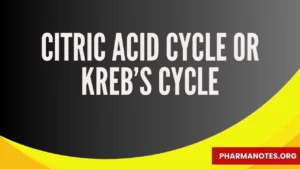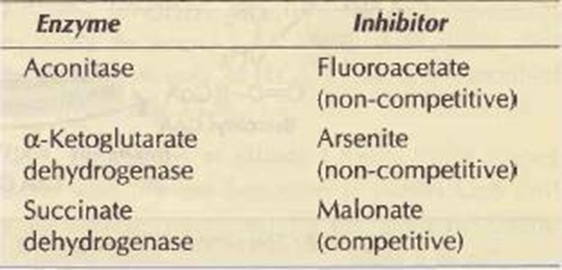Citric Acid Cycle or Kreb’s cycle

Objective
At the end of this lecture, student will be able to
• Explain the conversion of Pyruvate to Acetyl CoA
• Explain the reaction of Krebs cycle
• Describe the energetics of TCA
• Explain the regulation of TCA
Citric Acid Cycle or Kreb’s cycle
CONVERSION OF PYRUVATE TO ACETYL CoA
• Pyruvate is converted to acetyl CoA by oxidative decarboxylation
• It is a irreversible reaction, catalysed by PDH complex, which is found only in mitochondria
• High activity of PDH are found in heart & kidney
• PDH complex requires five coenzymes; TPP, lipoamide, FAD, CoA & NAD+
• The overall reaction is
• Pyruvate is decarboxylated to give hydroxyethyl TPP catalysed by PDH
• Dihydrolipoyl transacetylase brings about the formation of acetyl lipoamide and then catalyses the transfer of acetyl group to coenzyme A to produce acetyl CoA
• The cycle is complete when reduced lipoamide is converted to oxidized lipoamide by dihydro lipoyl dehydrogenase, where transfer of reducing equivalents to FAD
• FADH2 in turn, transfers the reducing equivalents to NAD+ to give NADH + H+, which can enters ETC to give 3 ATP (6 ATP from 2 moles of pyruvate formed from glucose)
Citric acid cycle or Kreb’s cycle
• Also known as citric acid cycle/tricarboxylic acid (TCA) cycle
• Most imp metabolic pathway for the energy supply to the body
• About 65-70% of the ATP is synthesized
• Involves oxidation of acetyl CoA to CO2 & H2O
• About 2/3 of total O2 consumed by body is utilizd for TCA
• It is the final pathway for carbohydrates, fats & amino acids
• Provides many intermediates required for the synthesis of amino acids, glucose, heme etc
• Proposed by Hans Adolf Krebs in 1937
• The enzymes of TCA cycle are located in mitochondrial matrix
• Krebs cycle basically involves combination of a 2C acetyl CoA with a 4C xaloacetate to producea 6C citrate
• In the reactions, 2C are oxidized to CO2 & oxaloacetate is regenerated and recycled
• Oxaloacetate plays a catalytic role in citric acid cycle
Reactions of Kreb’s cycle:
• Oxidative decarboxylation of pyruvate to acetyl CoA by PDH complex is a connecting link between glycolysis & TCA cycle
The reactions of citric acid cycle are as follows:
1. Acetyl-CoA to Citrate
2. Citrate to Isocitrate
3. Isocitrate to ά-ketocitrate
4. Oxalosuccinate to ά-ketoglurate
5. ά-ketoglurate to Succinyl-CoA
6. Succinyl-CoA to Succinate
7. Succinate to Fumarate
8. Fumarate to Malate
9. Malate to Oxaloacetate
1. Formation of citrate: acetyl CoA condenses with oxaloacetate by the citrate synthase to form citrate
Citrate is isomerized to isocitrate by aconitase with the formation of an intermediate cis-aconitate
2. Formation of a-ketoglutarate: Enzyme isocitrate dehydrogenase catalyses the conversion of isocitrate to oxalosuccinate and then to α- ketoglutarate. Formation of NADH & liberation of CO2 occur
3. Conversion of α-ketoglutarate to succinyl CoA:
• This step is carried out through oxidative decarboxylation, catalyzed by α-ketoglutarate dehydrogenase complex
• This enzyme is dependent on five cofactors-TPP, lipoamide, NAD+, FAD & CoA
4. Formation of succinate:
• Succinyl CoA is converted to succinate by succinate thiokinase
• In this reaction, GDP is phosphorylated to CTP (substrate level phosphorylation)
GTP + ADP ↔ATP + GDP
• GTP is converted to ATP by nucleoside diphosphate kinase
5. Conversion of succinate to fumarate:
• Succinate is oxidized by succinate dehydrogenase to fumarate
• In this reaction production of FADH2 occurs
9. Formation of malate:
• Fumarase catalyses the conversion of fumarate to malate with the addition of H2O
10. Conversion of malate to oxaloacetate:
• Malate is then oxidized to oxaloacetate by malate dehydrogenase
• Here synthesis of NADH occurs
• The oxaloacetate is regenerated which can combine with another molecule of acetyl CoA and continue the cycle
Summary of TCA cycle
Acetyl CoA + 3NAD+ + FAD + CDP + Pi +2H2O → 2CO2 + 3NADH + 3H+ + FADH2 + GTP + CoA
Inhibitors of Krebs cycle
Energetics of TCA cycle:
• During TCA cycle, 4 reducinge quivalents (3 as NADH and one as FADH2) are produced
• Oxidation of 3 NADH by ETC synthesized 9 ATP
• Oxidation of 1FADH2 by ETC synthesized 2 ATP
• 1 GTP is converted to ATP
• Thus, 12 ATP are produced from one acetyl CoA
Regulation of citric acid cycle: regulation is either by enzymes or Availability of ADP level
• Citrate synthase → Inhibited by ATP, NADH, acetyl CoA & succinyl CoA
• lsocitrate dehydrogenase →Inhibited by ATP and NADH
• α-Ketoglutarate dehydrogenase → Inhibited by succinyl CoA & NADH
• P → Unless sufficient levels of ADP are available, oxidation of NADH and FADH2 through ETC stops
• Aaccumulation of NADH & FADH2 will lead to inhibition of the enzymes and also limits the supply of NAD+ and FAD which are essential for TCA cycle to proceed
Amphibolic nature of TCA cycle
• TCA cycle provides various intermediates for the synthesis of many compounds needed by the body
• TCA cycle is both cataholic and anaholic in nature, hence regarded as amphibolic
• TCA cycle is actively involved in gluconeogenesis, transamination and deamination
• The most important anabolic reactions are
1. Oxaloacetate & α-ketoglutarate:
• Serve as precursors for the synthesis of aspartate and glutamate which, in turn, are required for the synthesis of other non-essential acids, purines and pyrimidines
2. Succinyl CoA is used for the synthesis of porphyrins and heme
3. Mitochondrial c itrate is transported to cytosol, where it is cleaved to provide acetyl CoA for the biosynthesis of fatty acids, sterols etc
Anaplerosis or anaplerotic reactions
• The reactions concerned to fill up the intermediates of citric acid cycle are called as anaplerotic reactions or anaplerosis
1. Pyruvate carboxylase catalyses the conversion of pyruvate to oxaloacetate and an ATP dependent carboxylation reaction
Pyruvate + CO2 + ATP → Oxaloacetate + ADP + Pi
2. Pyruvate is converted to malate by NADP+ dependent malate dehydrogenase
Pyruvate + CO2+ NADPH+ H+ ↔ Malate + NADPH++H2O
3. Transamination is transfers of amino group to keto group and itself gets converted to a keto acid
The formation of α-ketoglutarate and oxaloacetate occurs by this mechanism
4. α-Ketoglutarate can also be synthesized from glutamate by glutamate dehydrogenase action
Glutamate + NADP+ + HO → α-Ketoglutarate + NADPH + H+ + NH4+
Summary
• Pyruvate is converted to acetyl CoA by PDH and is a irreversible reaction
• PDH complex requires five coenzymes; TPP, lipoamide, FAD, CoA & NAD+
• Also known as citric acid cycle/tricarboxylic acid (TCA) cycle
• 12 ATP are produced from one acetyl CoA
• Citrate synthase, lsocitrate dehydrogenase & α-Ketoglutarate dehydrogenase are regulators of TCA cycle
• TCA cycle is both cataholic and anaholic in nature, hence regarded as amphibolic
for Detailed PDF notes Click on download Button







